A little downwards movement was expected for the short term, which is what happened. The short-term targets remain the same.
Summary: For the very short term, a little more downwards movement to about 2,968 or 2,947 may continue next week. Thereafter, the upwards trend may resume. The next target is at 3,120.
Further confidence that a low is in place and price should make new all time highs very soon would come if either a 90% up day or two back to back 80% up days is seen.
A new low below 2,822.12 would add confidence to an alternate. Expect price at that stage to keep falling to 2,578 – 2,476 to find support at the lower edge of the large teal channel on weekly and daily charts.
The biggest picture, Grand Super Cycle analysis, is here.
Monthly charts were last published here, with video here. There are two further alternate monthly charts here, with video here.
ELLIOTT WAVE COUNTS
The two weekly Elliott wave counts below will be labelled First and Second. They may be about of even probability. When the fifth wave currently unfolding on weekly charts may be complete, then these two wave counts will diverge on the severity of the expected following bear market. To see an illustration of this future divergence monthly charts should be viewed.
FIRST WAVE COUNT
MAIN WEEKLY CHART
The basic Elliott wave structure consists of a five wave structure up followed by a three wave structure down (for a bull market). This wave count sees the bull market beginning in March 2009 as an incomplete five wave impulse and now within the last fifth wave, which is labelled cycle wave V. This impulse is best viewed on monthly charts. The weekly chart focusses on the end of it.
Elliott wave is fractal. This fifth wave labelled cycle wave V may end a larger fifth wave labelled Super Cycle wave (V), which may end a larger first wave labelled Grand Super Cycle wave I.
The teal Elliott channel is drawn using Elliott’s first technique about the impulse of Super Cycle wave (V). Draw the first trend line from the end of cycle wave I (off to the left of the chart, the weekly candlestick beginning 30th November 2014) to the end of cycle wave III, then place a parallel copy on the end of cycle wave II. This channel perfectly shows where cycle wave IV ended at support. The strongest portion of cycle wave III, the end of primary wave 3, overshoots the upper edge of the channel. This is a typical look for a third wave and suggests the channel is drawn correctly and the way the impulse is counted is correct.
Within Super Cycle wave (V), cycle wave III is shorter than cycle wave I. A core Elliott wave rule states that a third wave may never be the shortest. For this rule to be met in this instance, cycle wave V may not be longer in length than cycle wave III. This limit is at 3,477.39.
Cycle wave V may subdivide either as an impulse or an ending diagonal. Impulses are much more common. This main wave count expects that cycle wave V may be unfolding as an impulse.
The daily chart below will focus on movement from the end of primary wave 2.
In historic analysis, two further monthly charts have been published that do not have a limit to upwards movement and are more bullish than this wave count. Members are encouraged to consider those possibilities (links below summary) alongside the wave counts presented on a daily and weekly basis.
Within cycle wave V, primary waves 1 and 2 may be complete. Within primary wave 3, no second wave correction may move beyond its start below 2,728.81.
MAIN DAILY CHART
Primary wave 3 may have begun.
All of primary wave 3, intermediate wave (3) and minor wave 3 may only subdivide as impulses. Within each impulse, its second wave correction may not move beyond the start of its first wave.
Minor wave 2 may not move beyond the start of minor wave 1 below 2,822.12. It is still possible that minor wave 2 may continue lower as a double zigzag. The invalidation point is left the same to allow for this possibility. If price makes a new all time high in coming days, then the invalidation point will be moved upwards to the end of minor wave 2 at 2,855.96.
Minute wave i looks like a completed five wave impulse at the daily chart level. Minute wave ii should continue lower and last another one to few sessions for the wave count to have the right look at the daily chart level.
Intermediate wave (3) must move far enough above the end of intermediate wave (1) to then allow intermediate wave (4) to unfold and remain above intermediate wave (1) price territory.
HOURLY CHART
Minor wave 2 should be over.
Minor wave 3 may only subdivide as an impulse. Within the impulse, minute wave i may be over. Minute wave ii may continue as a relatively brief and shallow correction. The strong upwards pull of a third wave at four degrees may force minute wave ii to be more shallow than usual. The 0.236 and 0.382 Fibonacci ratios are reasonable targets.
Minute wave ii may be continuing as an expanded flat correction. Within the expanded flat, minuette wave (b) is a 1.27 length of minuette wave (a); this is within the common range of up to 1.38.
Minute wave ii may not move beyond the start of minute wave i below 2,855.96.
ALTERNATE WEEKLY CHART
Cycle wave V may be subdividing as an ending diagonal. Within ending diagonals, all sub-waves must subdivide as zigzags. Primary wave 1 may be over at the last all time high as a zigzag.
Primary wave 2 must complete lower as a zigzag.
The second and fourth waves within diagonals are usually very deep, commonly between 0.81 to 0.66 the depth of the prior wave. This gives a target zone for primary wave 2.
Primary wave 2 may end if it comes down to find support at the lower edge of the teal channel, which is copied over from monthly and weekly charts. This trend line should provide final support for a deeper pullback.
Primary wave 2 may not move beyond the start of primary wave 1 below 2,346.58.
Within primary wave 2, intermediate wave (B) may not move beyond the start of intermediate wave (A) above 3.027.98. A new all time high would invalidate this wave count.
This alternate wave count is provided only for those members who wish to follow a more bearish wave count due to their own personal analysis. It is my judgement that this wave count has a very low probability.
SECOND WAVE COUNT
WEEKLY CHART
This weekly chart is almost identical to the first weekly chart, with the sole exception being the degree of labelling.
This weekly chart moves the degree of labelling for the impulse beginning in March 2009 all down one degree. This difference is best viewed on monthly charts.
The impulse is still viewed as nearing an end; a fifth wave is still seen as needing to complete higher. This wave count labels it primary wave 5.
Primary wave 5 may be subdividing as either an impulse or ending diagonal, in the same way that cycle wave V is seen for the first weekly chart.
TECHNICAL ANALYSIS
WEEKLY CHART
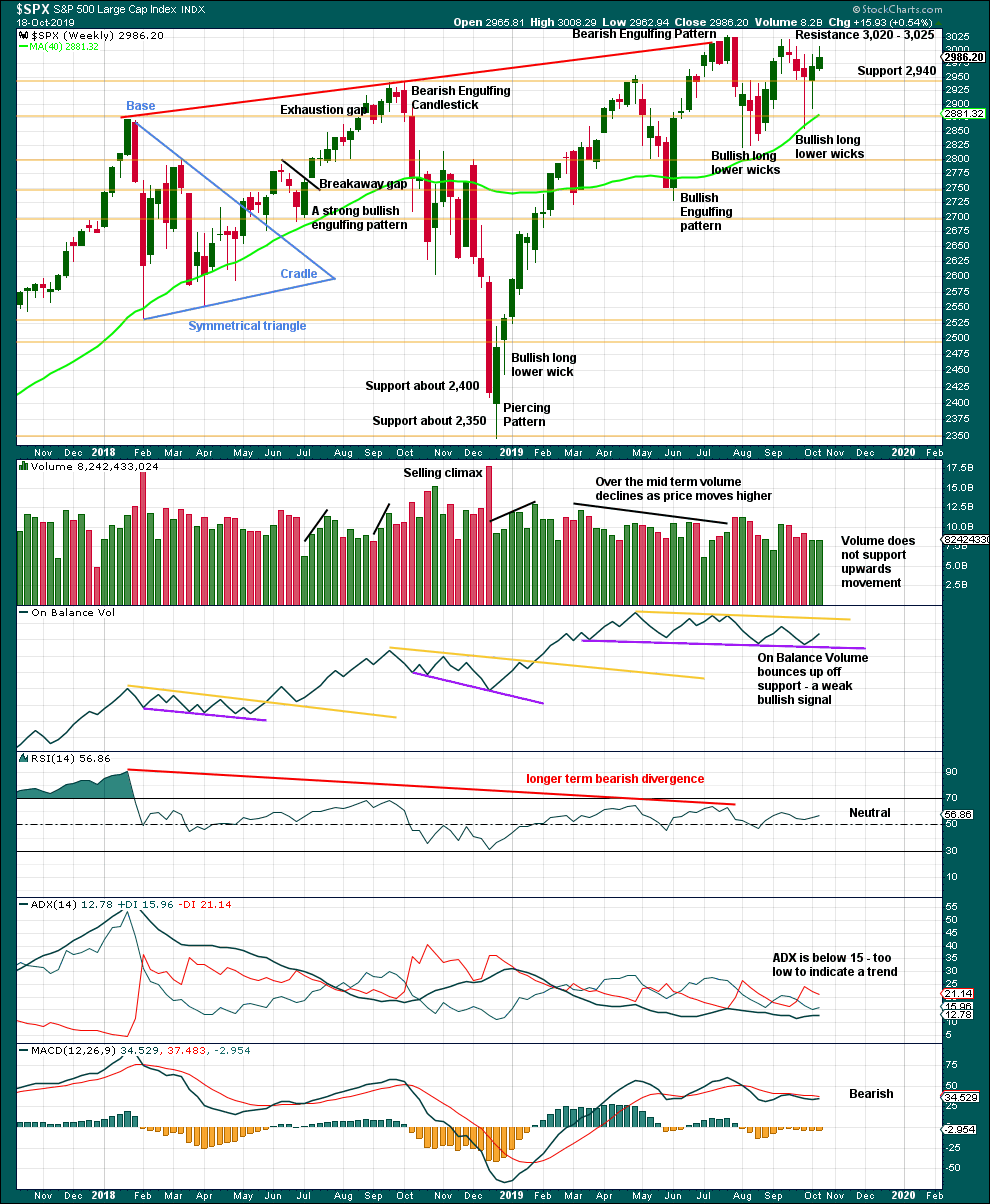
Click chart to enlarge. Chart courtesy of StockCharts.com.
A decline in volume with upwards movement is not of a concern in current market conditions.
A slightly longer upper wick this week suggests a pullback may continue next week. Look for support about 2,940.
There is still a series of higher highs (with the exception of the last high) and higher lows from the low in December 2018. This is the basic definition of an upwards trend. For that view to shift then a lower low below 2,822.12 would need to be seen.
DAILY CHART
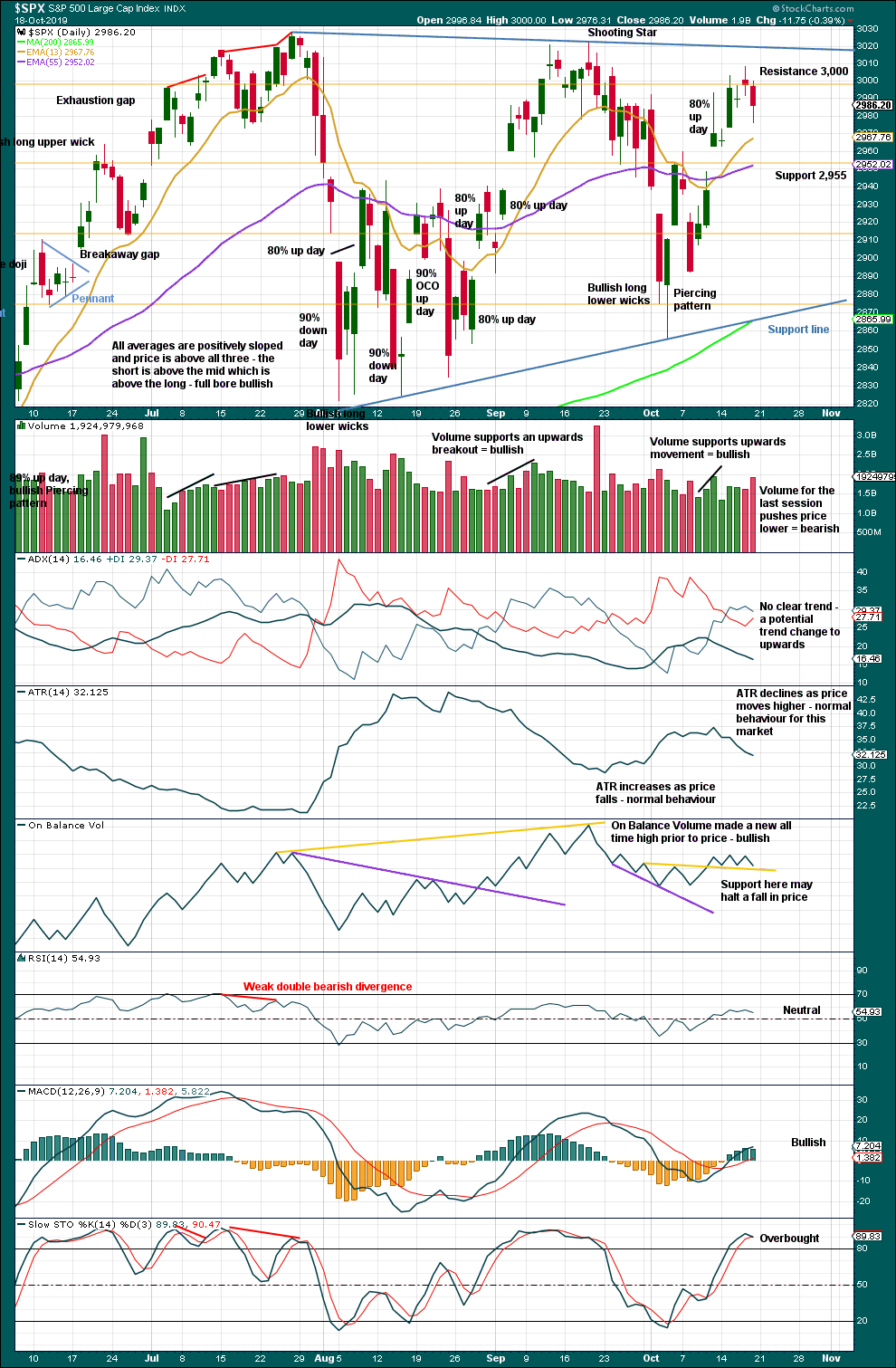
Click chart to enlarge. Chart courtesy of StockCharts.com.
There is now a series of higher highs and higher lows since the 5th of August. Strength in 90% up days and back to back 80% up days off lows indicate the lows may still be sustainable.
Strong volume pushing price lower on Friday suggests more downwards movement to begin next week. Downwards movements should be expected to be counter trend movements.
BREADTH – AD LINE
WEEKLY CHART
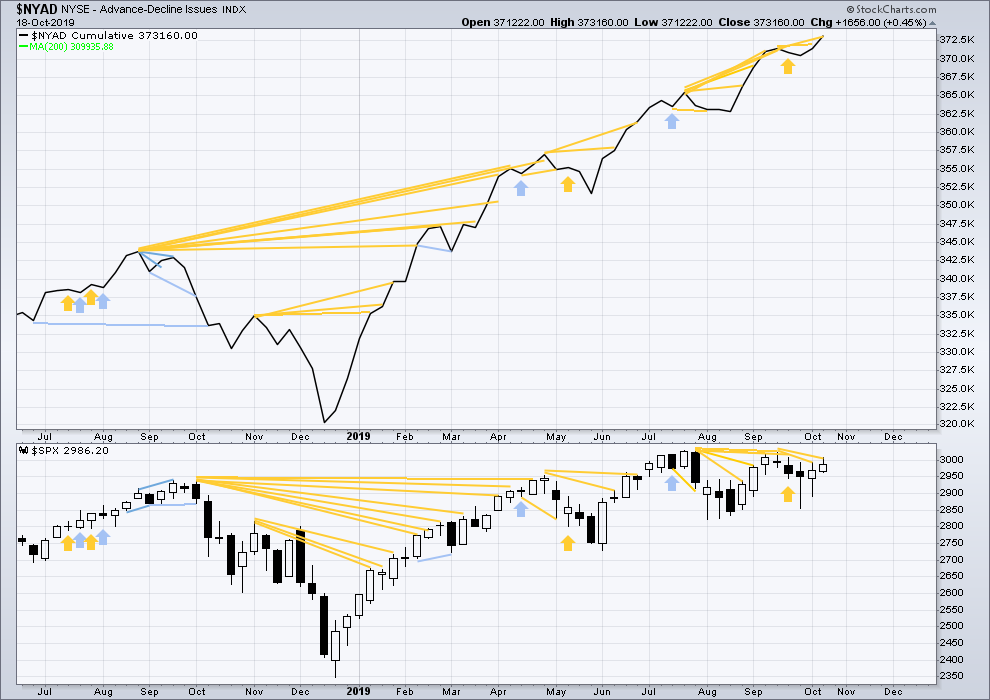
Click chart to enlarge. Chart courtesy of StockCharts.com. So that colour blind members are included, bearish signals
will be noted with blue and bullish signals with yellow.
Bear markets from the Great Depression and onwards have been preceded by an average minimum of 4 months divergence between price and the AD line with only two exceptions in 1946 and 1976. With the AD line making new all time highs again this week, the end of this bull market and the start of a new bear market is very likely a minimum of 4 months away, which is mid February 2020.
In all bear markets in the last 90 years there is some positive correlation (0.6022) between the length of bearish divergence and the depth of the following bear market. No to little divergence is correlated with more shallow bear markets. Longer divergence is correlated with deeper bear markets.
If a bear market does develop here, it comes after no bearish divergence. It would therefore more likely be shallow.
Small caps have made a new swing high above the prior high of the end of July, but mid and large caps have not yet done so. The last upwards movement appears to be led by small caps. Because small caps are usually the first to exhibit deterioration in the later stages of a bull market, some strength in small caps at this stage indicates a healthy bull market with further to run.
This week the AD line makes another new all time high. This divergence is bullish and strongly supports the main Elliott wave count.
DAILY CHART
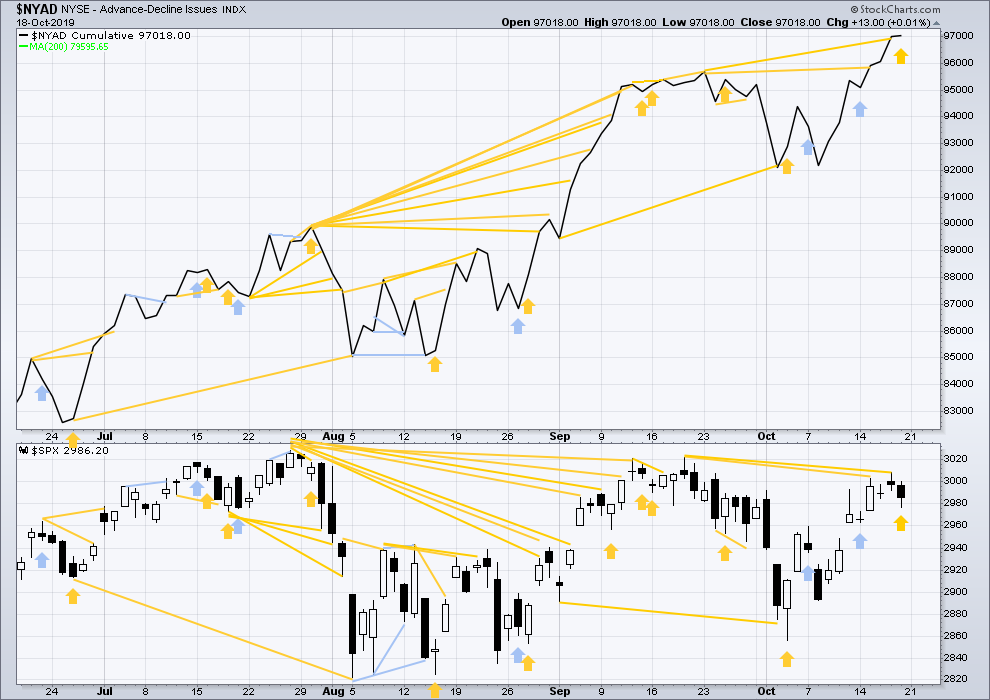
Click chart to enlarge. Chart courtesy of StockCharts.com. So that colour blind members are included, bearish signals
will be noted with blue and bullish signals with yellow.
Breadth should be read as a leading indicator.
On Friday price has moved lower, but the AD line is flat to very slightly rising. This divergence is bullish for the short term and suggests any downwards movement here (as indicated by volume) may be relatively brief and shallow.
VOLATILITY – INVERTED VIX CHART
WEEKLY CHART

Click chart to enlarge. Chart courtesy of StockCharts.com. So that colour blind members are included, bearish signals
will be noted with blue and bullish signals with yellow.
The all time high for inverted VIX (which is the same as the low for VIX) was on 30th October 2017. There is now almost two years of bearish divergence between price and inverted VIX.
The rise in price is not coming with a normal corresponding decline in VIX; VIX remains elevated. This long-term divergence is bearish and may yet develop further as the bull market matures.
This divergence may be an early warning, a part of the process of a top developing that may take years. It may not be useful in timing a trend change.
This week both price and inverted VIX have moved higher. Neither have made new short-term swing highs. There is no new divergence.
DAILY CHART
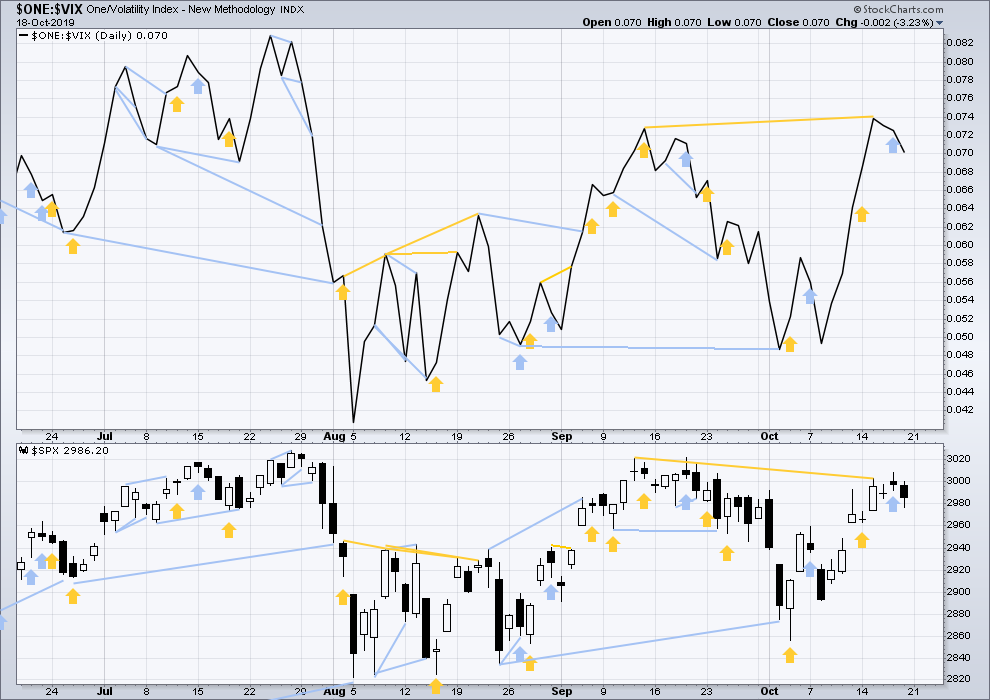
Click chart to enlarge. Chart courtesy of StockCharts.com. So that colour blind members are included, bearish signals
will be noted with blue and bullish signals with yellow.
On Friday both price and inverted VIX have moved lower. There is no new short-term divergence.
DOW THEORY
Dow Theory confirmed a bear market in December 2018. This does not necessarily mean a bear market at Grand Super Cycle degree though; Dow Theory makes no comment on Elliott wave counts. On the 25th of August 2015 Dow Theory also confirmed a bear market. The Elliott wave count sees that as part of cycle wave II. After Dow Theory confirmation of a bear market in August 2015, price went on to make new all time highs and the bull market continued.
DJIA: 23,344.52 – a close on the 19th of December at 23,284.97 confirms a bear market.
DJT: 9,806.79 – price has closed below this point on the 13th of December.
S&P500: 2,532.69 – a close on the 19th of December at 2,506.96 provides support to a bear market conclusion.
Nasdaq: 6,630.67 – a close on the 19th of December at 6,618.86 provides support to a bear market conclusion.
With all the indices having moved higher following a Dow Theory bear market confirmation, Dow Theory would confirm a bull market if the following highs are made:
DJIA: 26,951.81 – a close above this point has been made on the 3rd of July 2019.
DJT: 11,623.58 – to date DJT has failed to confirm an ongoing bull market.
S&P500: 2,940.91 – a close above this point was made on the 29th of April 2019.
Nasdaq: 8,133.30 – a close above this point was made on the 26th of April 2019.
Published @ 09:18 p.m. EST.
—
Careful risk management protects your trading account(s).
Follow my two Golden Rules:
1. Always trade with stops.
2. Risk only 1-5% of equity on any one trade.
—
New updates to this analysis are in bold.

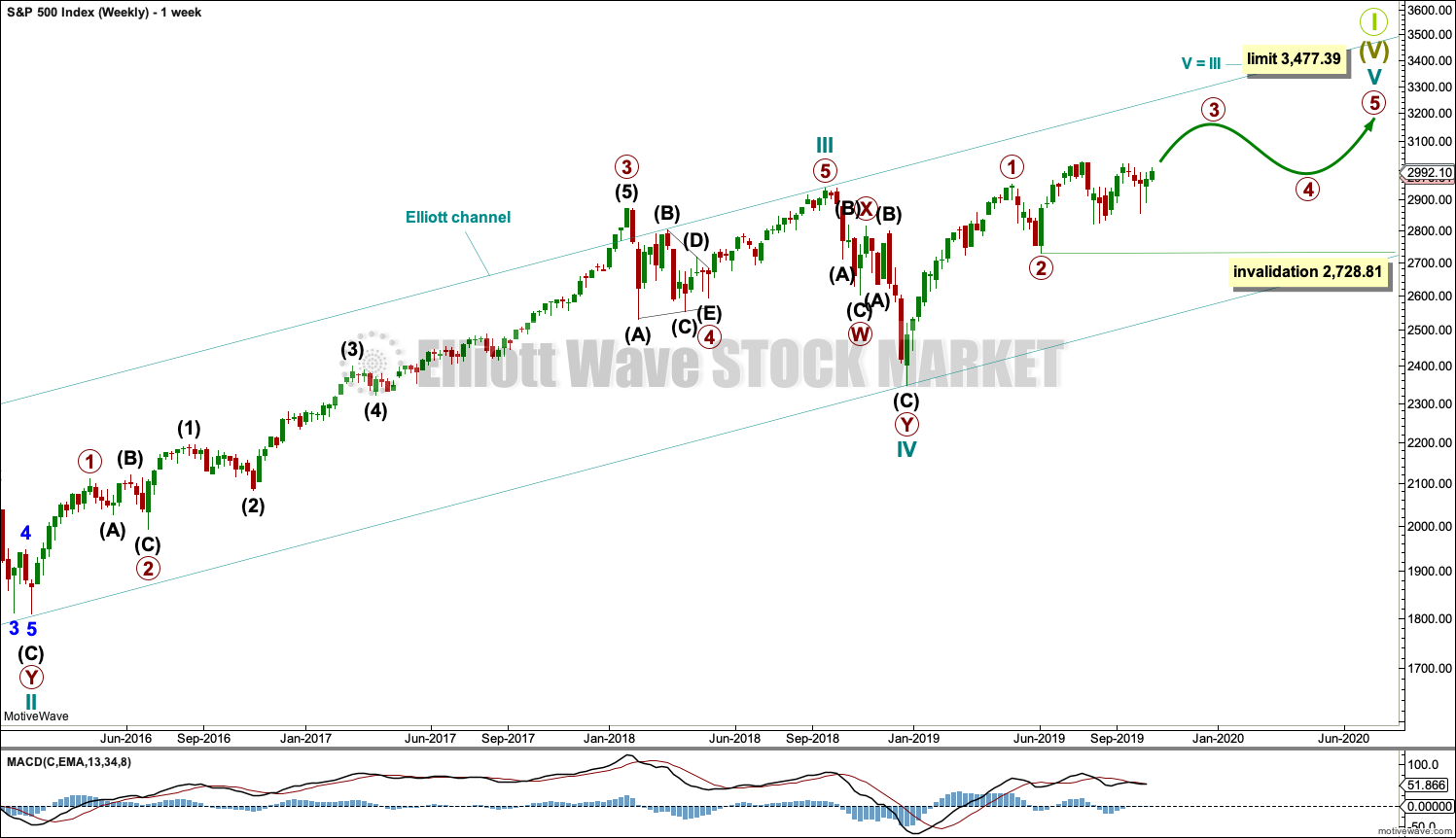
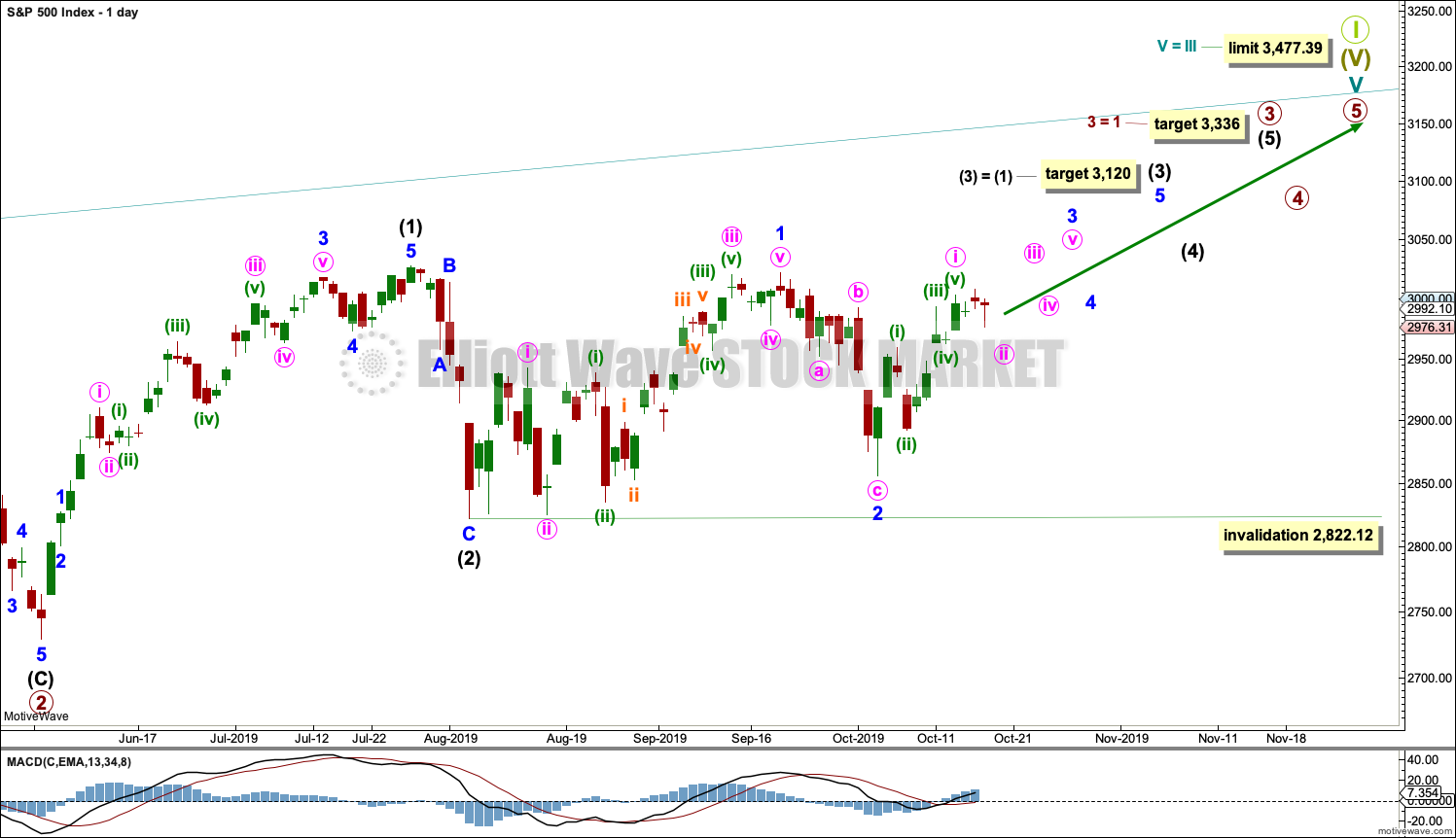
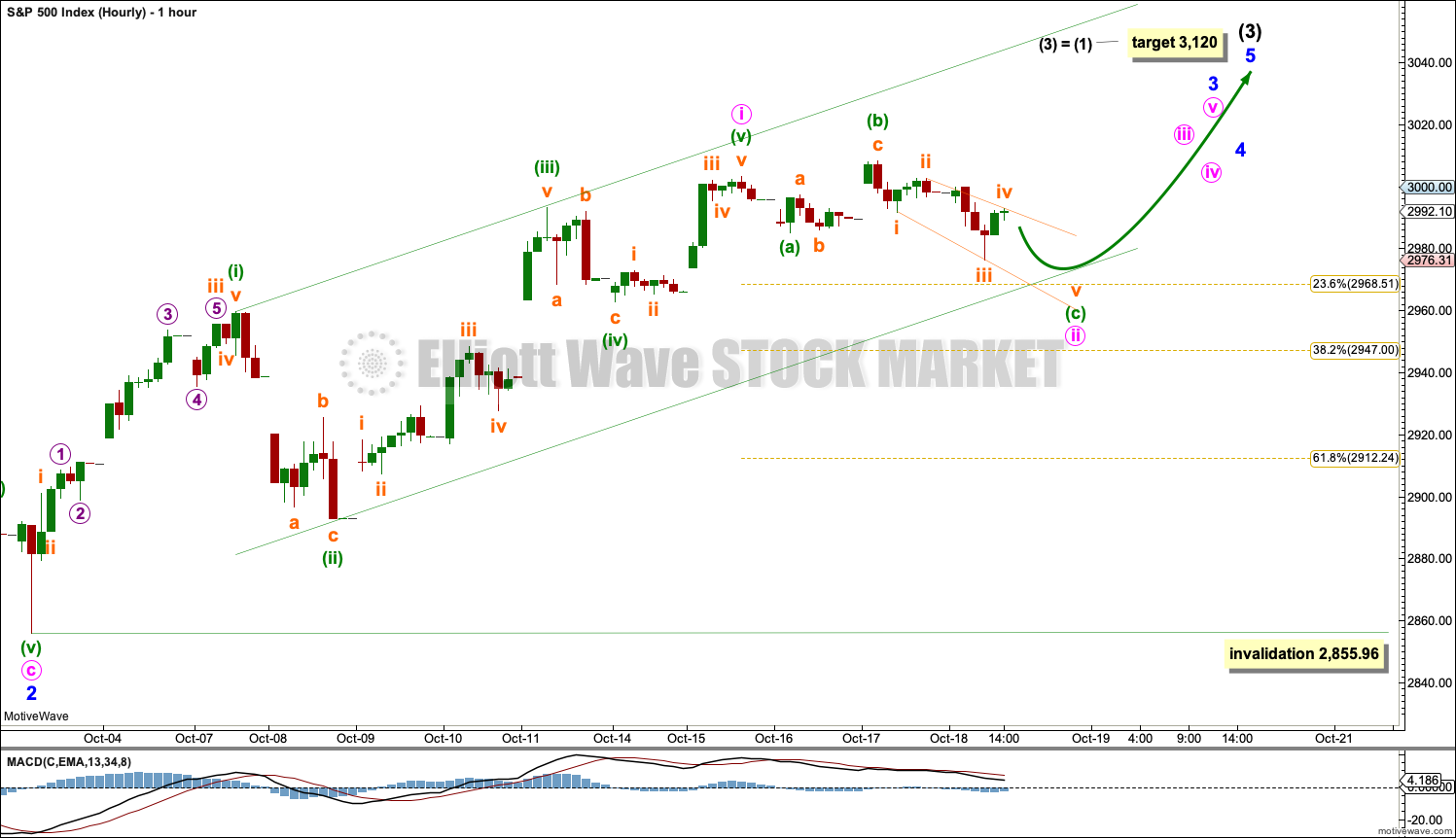
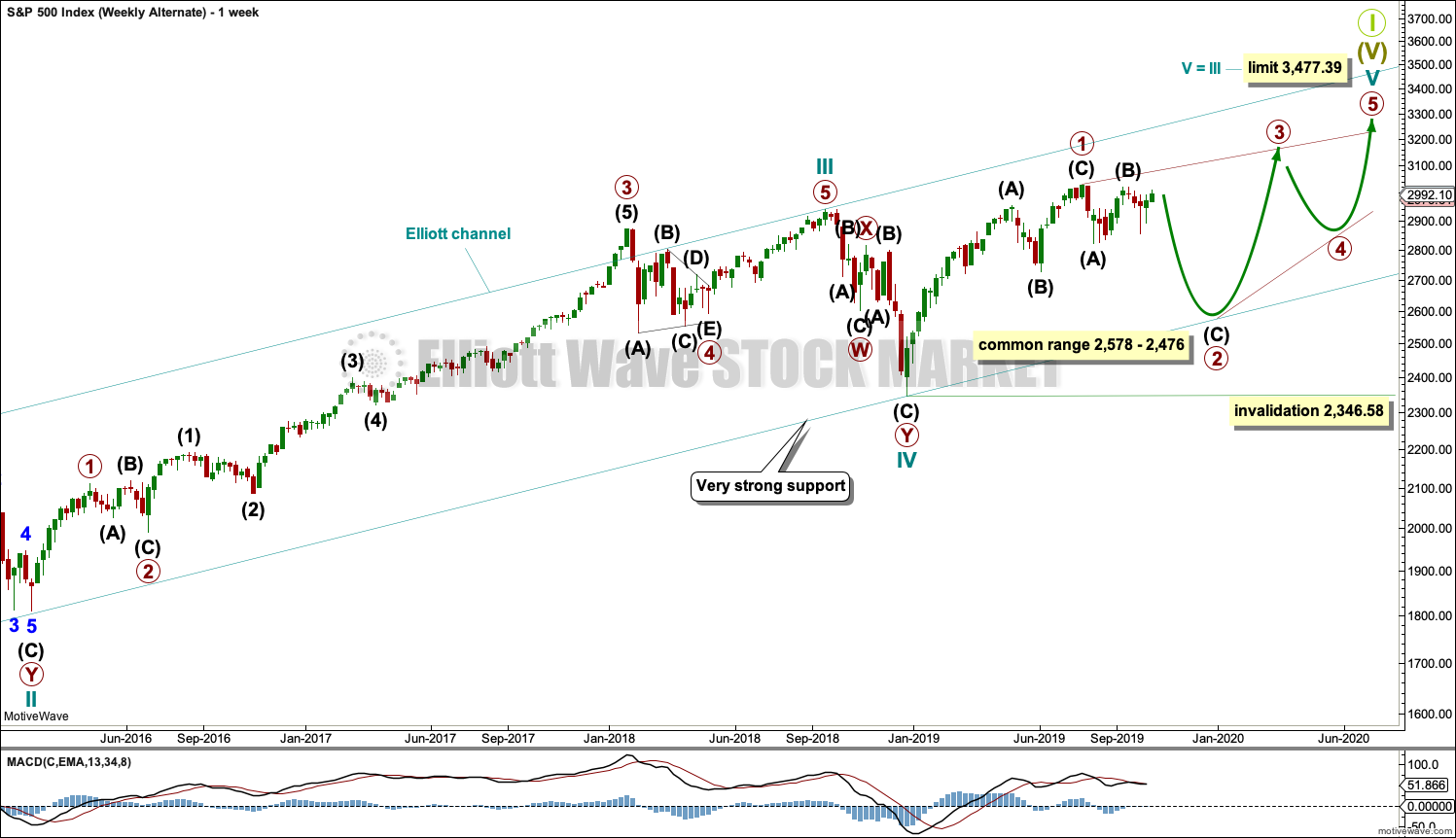

hourly chart updated
it’s possible that minute ii was over as a shallow brief correction
up and away in the channel?
or over and down to build a bigger minute ii?
crux time tomorrow….
Anyone notice SPY volume so far today?
Yeah, really poor… don’t trust this rally on such aweful volume
Kevin,
I have to admit, your 49r’s seem to be for real. It is amazing what a good coaching staff can do for a team.
And exceptional drafting and recruiting. LOTS of talent on the 9’rs. And a lot of that talent injured but coming back over the next several weeks. Darn I wish I’d gotten myself a “49rs to win super bowl” ticket before the season opened! I bet they were probably 30-1 or worse. Now I suspect they are about 4-1.
We’ll really see how good they are when they play the Seahawks and then the Packers.
Note that while this is Jimmy G’s 3rd year as as starter, he is still in many respects a rookie (I think he just started his 14th or 15th game is all). He’s only going to keep getting better.
I’ll say I enjoy pro football again now. 3-5 years ago when it was a head hunting game I could barely watch it. Now that’s stopped and they are playing football again. Nice to see.
In a bullish wave count at 4 degrees of 3rd of 3rd, surprises will be to the upside. This morning is an example. This does not mean we have broken out to the upside. It is just an indication of which way we should be prepared to be surprised. Can one be prepared for a surprise? Hmmm.
RUT has hit and is stalling at a projected potential swing high at 1552.5. Not saying the big swing up is over, only that it’s now at a higher potential price zone for a pivot back down.
Of course, AD counts are very bullish in RUT at 1670-290 or so. SPX not quite so hot at 361/137.
RTY has been incredible recently
And RUT is in its seventh straight month of squeeze. Eventually, it’s going to take off like a rocket, out of this “thin and flat” sequence of monthly bars that just goes sideways on the monthly chart. Here’s my bull count for RUT. This gets lots of confirming evidence if/when price breaks above the long consolidation range (above 1618). The diagonal black lines are symmetric projections of prior up swings.
you can’t label y within (2) as a multiple
w-x-y within any of W, Y or Z is invalid
because the maximum number of corrective structures in a multiple is 3, and that multiplies it beyond 3 violating the EW rule
My trend indicator is flashing caution here. Monthly trend down. Weekly trend down. Daily trend neutral.
Note also that the monthly is in month 7 of squeeze, and a squeeze just started on the weekly. This market continues to build up energy that is going to propel a strong move, presumably up. At some point. But the market behavior has been to consolidate in this range for a long time now, and I think it’s more probable to continue than not. )Hence the down trend indicators.) Until it doesn’t anymore.
Forgive my ignorance Kevin. But how are the monthly and weekly charts showing down trends and the daily isn’t ?
Trend is time frame relative (regardless of how you measure it). A chart in a huge monthly up trend can at the daily or hourly level be pulling back and the trend at those time frames can be down. And vice versa. The charts I’m showing here for SPX has monthly trend “orange” which means the ADX is rising while the -DI is above the +DI when DMI is applied to the monthly chart. Similar when applied to the weekly: the most recent bar is orange, also showing a down trend. But at the daily time frame the final bar is purple, indicating neutral trend, and the prior trend was down. That means that DI+ has moved above DI-, but ADX is still moving down, not up. Hence, “mixed trend”, hence, neutral.
The weekly video released yesterday by C. Ciovacco makes a very long term review, long term even for Mr. Ciovacco. I recommend it to all. Of course, I always recommend all members here, watch Lara’s weekly video, if for no other reason than it is the best EW teaching resource available anywhere.
Thanks Rodney – is there a link to the C. Ciovacco video? And I agree – Lara’s videos are fantastic.
Sure. Here it is:
https://www.youtube.com/watch?v=C5Oj0ZBrb58
You can also go to the Ciovacco Capital website and find it under ‘Short Takes’ which is here:
https://www.ccmmarketmodel.com/short-takes
Below is a chart of the NYSE. I put it here just for fun and entertainment.
#1. But I’ll leave it for someone else.
I’m not picking that up. Happily #2. The chart is exciting. Let’s go!